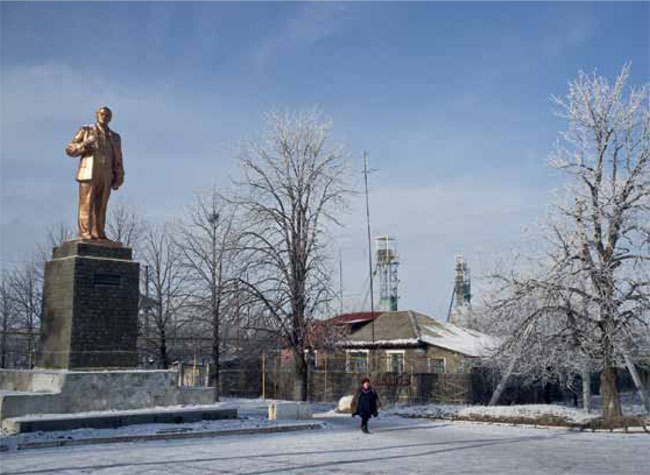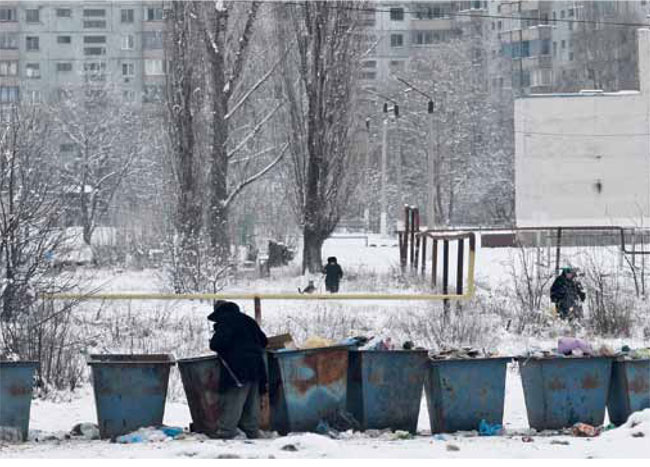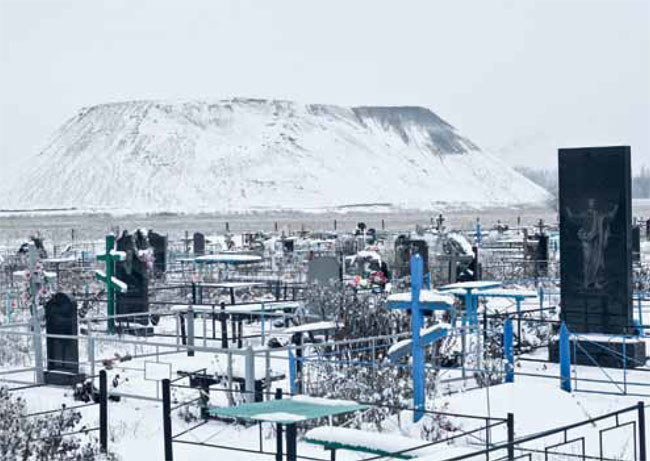Just like any historically industrial region, most populated areas in the Donbas sprung up near plants and coal mines. However, a growing number of unprofitable enterprises have been shut down in the past two decades, causing a catastrophic loss of jobs and complete decline of infrastructure. To the locals, this means no traditional sources of support. Migration ensues, and entire districts turn into ghost towns. Underlying all these sad developments is the overall inefficiency of the social economic system in the Donbas.
DEADLY RESTRUCTURING
Deindustrialization and depopulation are typical of any post-Soviet city or town, but the Donbas is special in that it is a purely industrial region in the manner of the late 19th-century. Both the economic cycles and local mentality revolve around large industrial complexes as a certain sacral symbol, an object of pride and even a totem. “To me, a city without industry is kind of fake,” Oleh Sestrin, a Mariupol-based worker who comes from a family of workers. This type of thinking predominates in the region and has driven the locals into a dead end over the past decades.
“The catastrophic decline of industry in the Donbas has affected the psyche and mentality of the population in several major ways,” Donetsk-based psychologist Andriy Bashkirov says. “Of course, when you lose nearly all your usual ways of making money virtually overnight, you become terrified at the prospect of any further change and will hold onto even the little you have now. This is the obsessive desire for ‘stability’ which spin doctors are exploiting. However, the impact of deindustrialization has gone much deeper.

Stuck between epochs. Residents of Zorynsk do not see any prospects for the future and are nostalgic about the past
Given the industrial orientation of all aspects of local life and workers traditions like coal mining dynasties, shock-worker records and proletarian pride in one’s own plant, people without their own enterprise tend to lose their sense of purpose in life. The traditional foundations of their lives have been ruined. Citizens stop appreciating and loving the place where they were born and lived their entire lives. This is the root of all the problems in Ukraine’s ‘black belt’ – alcoholism, disregard for the law, rampant crime, and so on. The Donbas is still living with the consequences of this history, to say nothing of the real depopulation of small towns and villages.”
The bankruptcy of a coal mine is often a real death verdict to a coal mining settlement and its inhabitants, because it forces locals into subsistence agriculture. A coal mine means not only jobs that are a source of living but also a utilities infrastructure, social and other provisions, a sense of being needed, and more. No-one offers any alternative jobs when enterprises close, and since the 1990s, the region has suffered from depopulation and extreme social labour emigration.
“The so-called restructuring was in many cases unnecessary,” Oleksandr Ilchenko, a public activist, entrepreneur and former coal miner from Sverdlovsk, Luhansk Oblast, says. “The coal mining industry was destroyed on purpose in the 1990s. The local authorities were given a carte blanche from Kyiv to sell off products, extremely expensive equipment and enterprises into private hands. The entire region was on the edge of survival, while a handful of those who now make up the so-called local elites filled their pockets. This process has slowed down somewhat but continues even now, because 90 per cent of enterprises that were closed will never resume operation. Consequently, people who used to work there have been forced to seek a better life outside their own home towns because they can no longer survive in them. Neither the local nor the central authorities are doing anything to offer residents of what used to be coal mining settlements any other economic prospects.”
ABANDONED MINES, ABANDONED HOMES
Luhansk Oblast is a vivid example of the overall situation in the Donbas. As of early 2012, there were 11,500 abandoned flats and homes in the oblast. This official number is just the tip of an iceberg. Experts say that in many cases officially registered residential property owners left the area as migrant workers a long time ago, with zero chance of returning. The true number of abandoned homes may be 2-3 times higher.
Entire districts have become desolate in some depression-struck cities. For example, 9 out of 12 coal mines that provided jobs for the coal mining town of Brianka, 58km from Luhansk, were closed during large-scale industrial restructuring. This government manoeuvre triggered a humanitarian catastrophe. The population of the town has dropped nearly 50% in the past 20 years. People fled in different directions to survive, abandoning their homes. In the mid-1990s, selling a piece of residential property in the Luhansk hinterland for US $100-300 was considered a great success.
Oleksandr, 30, a Luhansk resident, remembers that in 1996, his family sold a two-room flat in the depressed town of Zorynsk with a plot of land as a bonus for US $300. He believes they were lucky, because one year later their neighbours were unable to find a buyer for their flat, so they simply locked it up and left for Russia.
As we enter Zorynsk, the cone of a coal mine welcomes us. The coal mine is no longer operating and looks like the skeleton of a huge iron monster. What immediately catches the eye is the multitude of abandoned houses, first individual homes and then entire blocks of flats. The destruction of the town is close to complete – nearly all the locals we met said they worked outside of town and dreamt of leaving it as most of their relatives and acquaintances had done. The only thing that permits several thousand local residents to survive there is the M-04 highway to Izvaryne on the border and jobs in Alchevsk.

The order is to survive. Sukhodolsk tries to attract new residents by offering abandoned flats free of charge
A major problem for residents who are not even directly linked to industrial production is the absence of any alternative in the local economic system, which is another cause of permanent emigration. “No-one will understand you, if you don’t want to work at a plant,” painter Andriy Siry, a Yasynuvata native and now Kyiv resident, explains. “They put pressure on you since childhood if you dare dream of something that does not fit into the local cultural code. What? You want to paint? Plants are standing idle in the country, but everyone wants to be a painter, they will tell you. So people like myself have never had a choice in contemporary Donbas – we have had to leave as soon as an opportunity presented itself, without waiting for a better chance. If you need to abandon your flat, then so be it – it can go to hell.”
“I don't remember my hometown very well,” Serhiy Halkin, a native of Snizhne Donetsk Oblast, says. His family was fortunate enough to be able to move to Boryspil, near Kyiv. “We left Snizhne in 1997 when the local coal mine where my father and grandfather worked was shut down. There were no jobs available, and the situation was so desperate that even food products were not delivered to grocery stores on a regular basis. But we didn't have money to buy them anyway. There is not much I remember from my childhood years in Snizhne, except a lot of Lenin statues. I have never gone there after we left, and, frankly, I don't feel particularly drawn.”
REDUCING DEPENDENCY
The cities where the coal mining industry kept at least some of its position thanks to privatization have a lower depopulation rate. For example, the infamous town of Sukhodolsk, where 28 coalminers were killed in an accident in 2011, has started to see people returning to their abandoned flats. This is even despite the fact that, statistically, this town is among the fastest shrinking municipalities in Ukraine.
From the very first glance, Sukhodolsk appears depressed: grey streets, battered houses that have not been kept up or remodelled since the breakup of the USSR abound and locals are few. Abandoned flats are reminiscent of all the depressed towns in the region. Especially phantam-like are blocks of flats with alternating populated and abandoned floors. For example, there is a grate on the fourth floor in a 12-storied building in the city outskirts – there is no way up from there. “It’s a good thing that they blocked the passage not so long ago,” a local resident says. “Drug addicts used to have a den up there. On the other hand, a young couple recently got permission to occupy an abandoned flat nearby. And they did move in. Now they are trying to remodel the place.”

Going nowhere. The absence of any alternative is gradually killing the Donbas
The Sukhodolsk authorities encourage people to occupy abandoned flats. They are handed over free of charge, but the cost of remodelling falls on the new owners. In this way, some ghost buildings are coming back to life.
But will it last? For the past two years, the Mykola Azarov government has repeatedly declared that the coal mining industry is very significant for the state due to its desire to reduce dependency on Russian natural gas. Hence a revival of this sector was to be expected, the government assured. However, economic experts say that powerful oligarchs have much to lose if they decide to switch to coal: they will have to overhaul their production lines at great expense. In other words, these coal mining regions should not expect any positive changes soon.
The biggest problem is that the authorities are not even trying to diversify the economy of the Donbas, which remains dominated by heavy industry and coal mining. This perpetuates the dependency of the local population for survival on these sectors, which are now uncompetitive due to their outdated technology, inefficient use of labour and dependence on raw materials rather than finished products. Most production facilities are privately owned, but the owners invest almost nothing in upgrades. If this situation continues, plants and coal mines will continue to close and towns will lose their inhabitants.
In short, the entire socioeconomic system of the Donbas is in a dead end and mere production reform will not suffice to revive it. Measures must also be taken to help people who have lost their jobs in industry after restructuring. The Donbas will have to go through this painful but much needed process at some point, just like its foreign counterparts have done, from the Ruhr region in Germany to Wales in the UK. And this should be done before it is too late.
DYING TOWNS
Stepnohirsk is a small town in Zaporizhia Oblast located on the bank of the Kakhovka Water Reservoir. It was abandoned by residents after its coal mines closed
Snizhne is an oblast-level town in Donetsk Oblast which is suffering from continuing depopulation caused by deindustrialization
Petrovske is a county-level town in Luhansk Oblast which has been dying since the closure of the Hryhoriy Petrovsky Chemical Association
Vuhlehirsk is a county-level town in Donetsk Oblast located near Yenakievo. The breakdown of the coal mining infrastructure triggered emigration there.
Torez is an oblast-level town in Donetsk Oblast which has been gradually losing its population after all of its coal mines and plants were closed.

